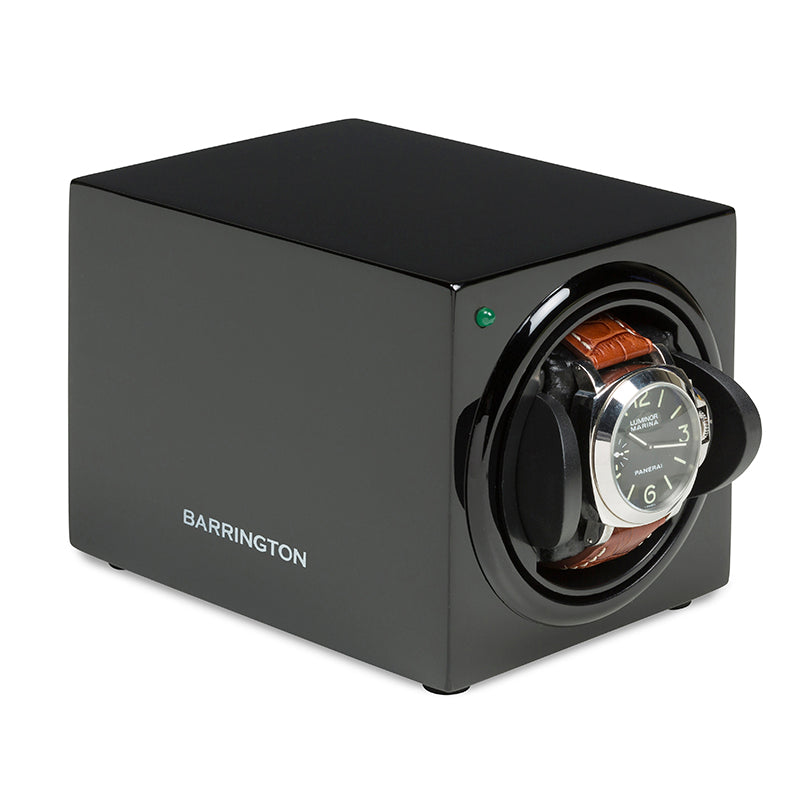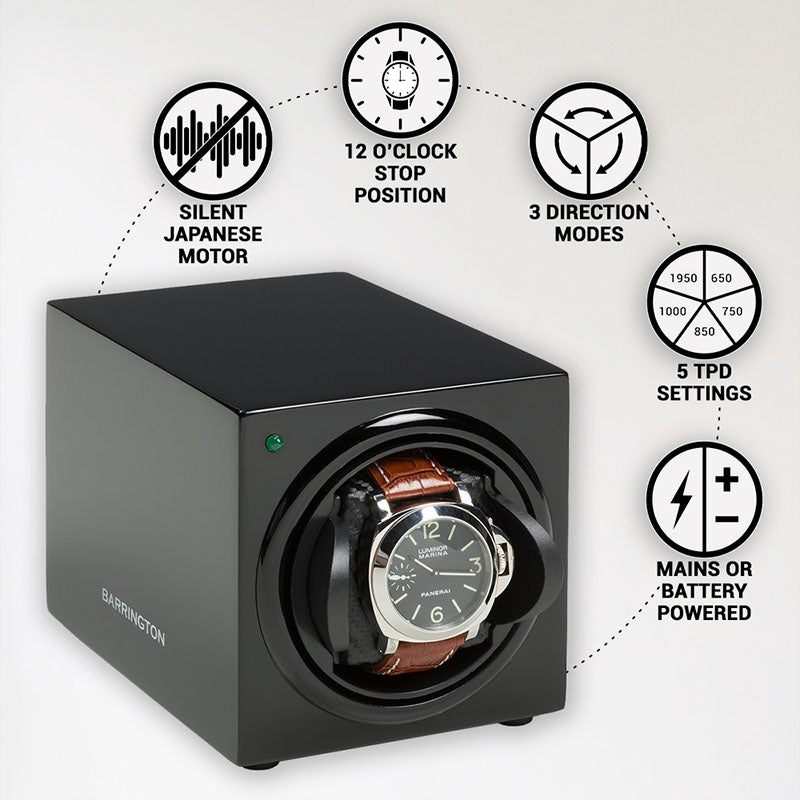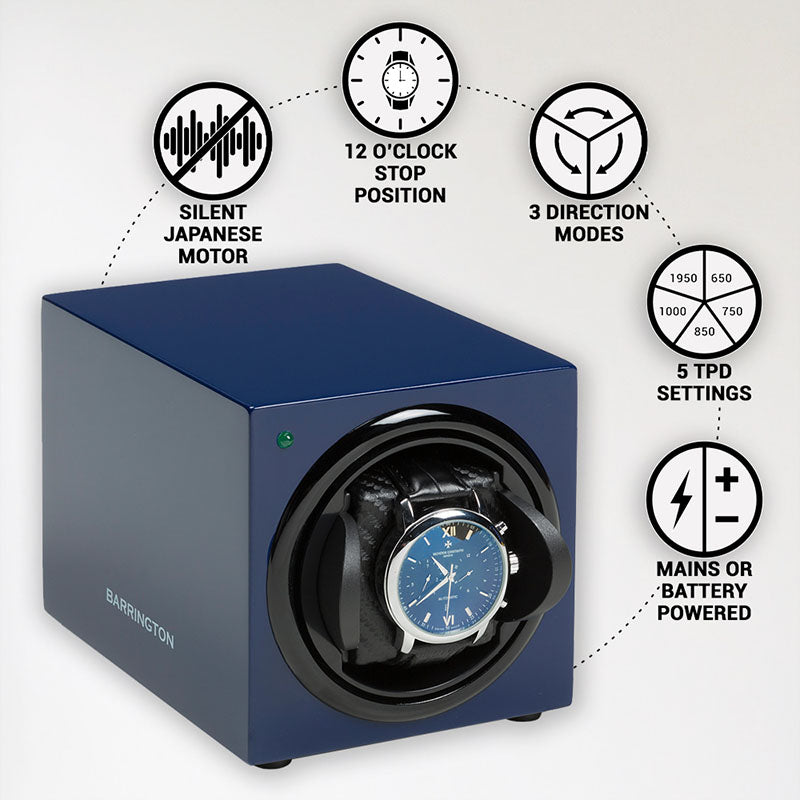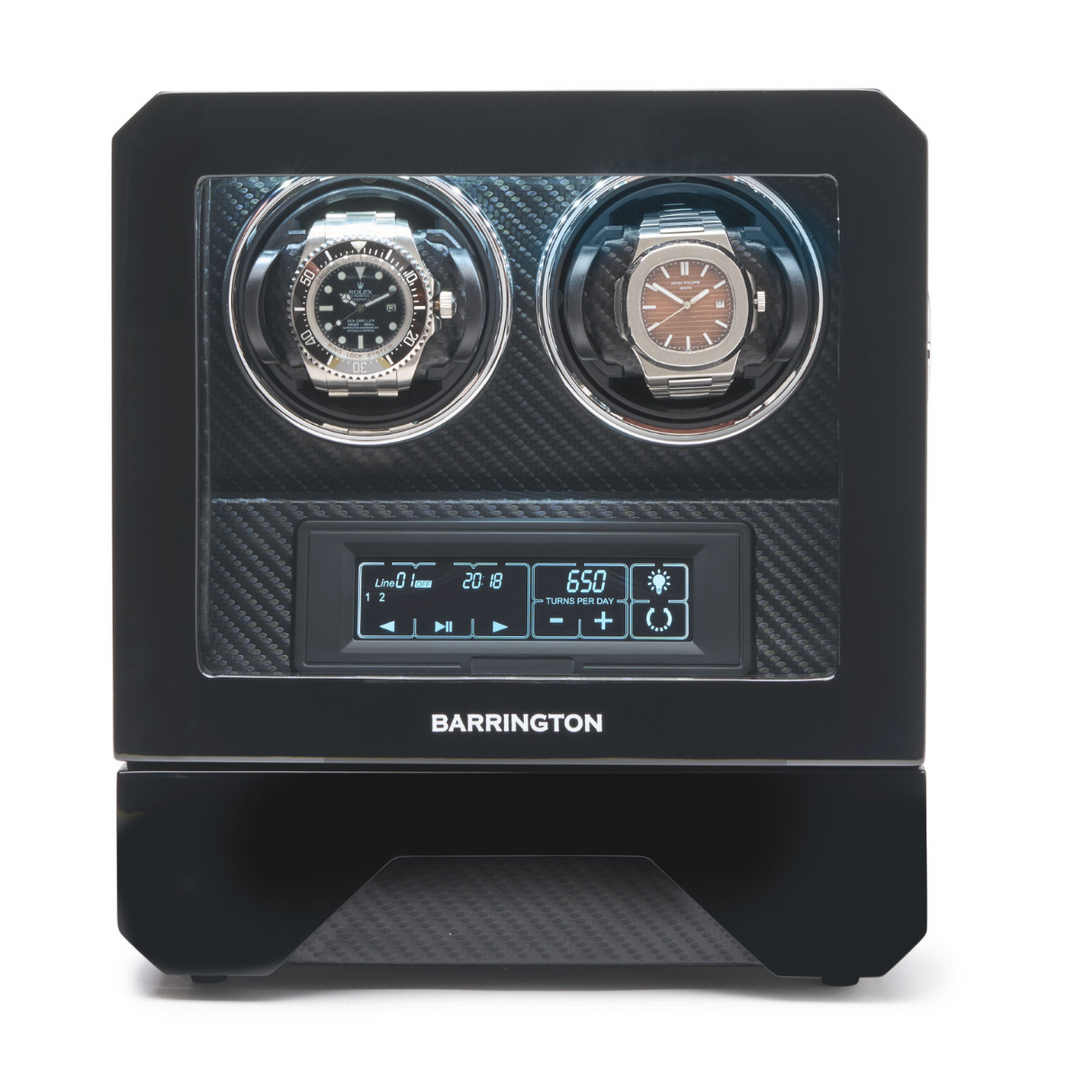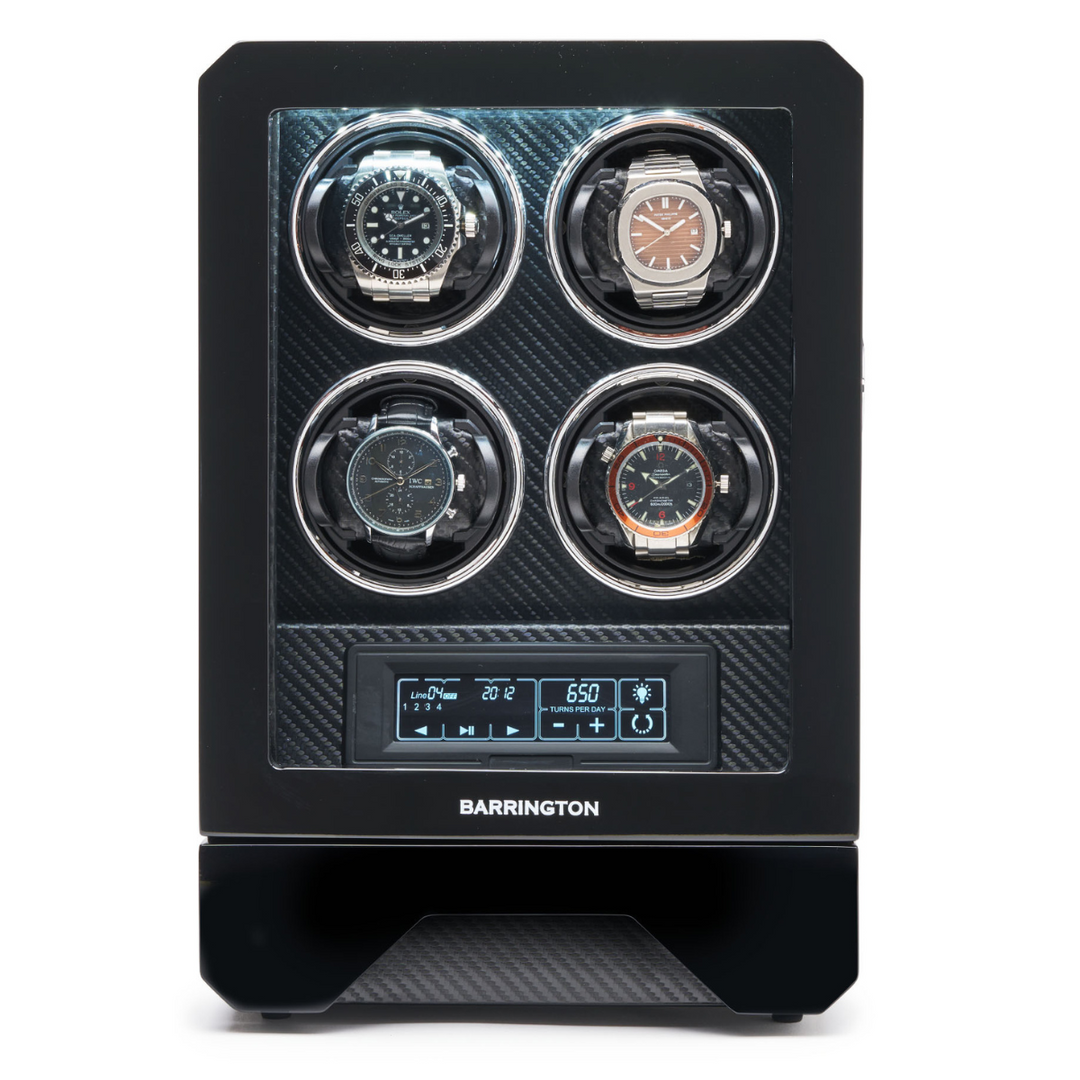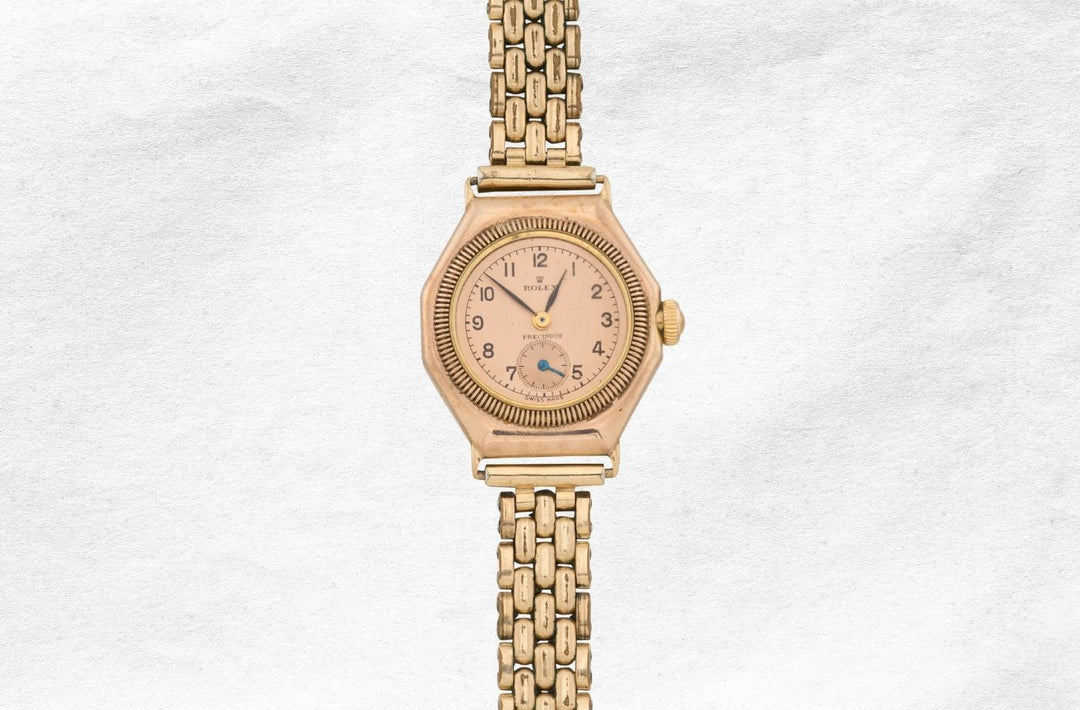Mastering Watch Winders: Essential Guide | Barrington Watch Winders
How to Wind a Watch: Dos and Don'ts for Watch Winders
In recent years, the watch industry has witnessed a significant revival of interest in automatic watches. This resurgence is not just about nostalgia for the intricate craftsmanship of yesteryears but also an appreciation for the mechanical precision and artistry that automatic watches represent. Unlike their quartz counterparts, automatic watches harness energy through the natural motion of the wearer's wrist, which activates the winding mechanism crucial for maintaining accurate time. As enthusiasts and collectors have grown, so too has the demand for a reliable way to keep these watches running optimally when not in use.
A watch winder serves an essential purpose for automatic watch owners: it keeps the watch wound and ready to wear. This device is particularly beneficial for those with an extensive collection or watches with complex features such as perpetual calendars and moon phases, which can be cumbersome to set if they stop. The utility of a watch winder goes beyond mere convenience; it is a tool that ensures the longevity and accuracy of your treasured timepieces by maintaining the tension in the mainspring uniformly. As such, understanding how to effectively use a watch winder and the dos and don'ts associated with it is crucial for any automatic watch enthusiast.
What is a Watch Winder?
A watch winder is a device designed to maintain the power reserve of an automatic watch. Automatic watches are engineered to wind themselves as they are worn by using the movement of the wearer's arm to activate a rotor, which in turn winds the watch’s mainspring. However, when an automatic watch is not worn for an extended period, it can stop, necessitating manual resetting of time, date, and other functions. A watch winder simulates the motions of the wrist, ensuring that the watch remains fully wound and ready to wear.
The core function of a watch winder is relatively straightforward but ingenious. Inside the winder, a motor turns a holder where the watch is mounted. This rotation mimics the natural movement of the wrist and activates the rotor inside the watch, which only moves in response to motion. The rotor pivots around its staff, with each movement winding the mainspring slightly. Over time, this keeps the watch not only running but also ensures that the lubricants within the watch movement are evenly distributed, which is essential for maintaining the watch’s mechanical integrity and accuracy.

Watch winders vary greatly in complexity and features. Basic models may offer single direction rotations, while more advanced winders provide bi-directional rotations and adjustable settings for Turns Per Day (TPD), allowing customization to the specific winding needs of different watch models. By maintaining a constant movement, watch winders help prolong the life of the watch and ensure its ready use without the need for adjustment and rewinding.
The Benefits of Using a Watch Winder
Owning an automatic watch brings a sense of craftsmanship and sophistication, but it also requires consistent movement to keep running. A watch winder offers several key benefits, especially for collectors and enthusiasts who own multiple timepieces. Let’s explore the main advantages of using a watch winder.
One of the primary benefits of a watch winder is its ability to keep an automatic watch in continuous operation, ensuring that the time, date, and any other complications (such as moon phases or perpetual calendars) remain accurate. When an automatic watch is not worn for a certain period, it will stop, requiring manual resetting of all functions, which can be tedious, especially for watches with intricate features. A watch winder ensures that your watch never loses power, eliminating the need for constant manual adjustments and reducing wear on the crown from frequent winding.
For collectors who rotate between multiple watches, a watch winder is an invaluable tool. If you do not wear the same watch every day, keeping each timepiece wound and functional can be challenging. A watch winder saves time by maintaining the power reserve of all automatic watches in your collection, ensuring they are ready to wear whenever you choose. This is particularly useful for watches with complex settings that require significant effort to adjust after a complete stop. With a watch winder, you can easily switch between watches without the hassle of resetting each one.
How to Choose the Right Watch Winder
Selecting the ideal watch winder requires careful consideration of your specific needs and preferences. With a variety of models available, each offering different features, it's important to evaluate key factors to ensure your timepieces receive the proper care. Let’s take a closer look at the essential aspects to consider when choosing the right watch winder.
Key Factors to Consider
When selecting a watch winder, it's important to keep in mind several key factors that will ensure the optimal maintenance and functionality of your timepieces. Automatic watches have different requirements depending on their movement, size, and the frequency with which they are worn. The right watch winder will cater to these specific needs while also fitting your lifestyle and collection size. Below are the most critical factors to evaluate when choosing a winder.
-
Size and Number of Slots: The first factor to consider is the size of the watch winder and the number of slots it offers. If you own multiple automatic watches, a winder with several slots may be necessary to accommodate your collection. For those with a single watch or a small number of timepieces, a compact winder with one or two slots might be more appropriate. Additionally, ensure the winder has adjustable cushions to securely fit watches of varying sizes and strap types.
-
Turns Per Day (TPD) Settings: The TPD setting determines how many rotations the winder makes in a day, which is crucial for maintaining the correct tension in the mainspring. Different watches require different TPD settings, typically ranging from 650 to 1950 turns per day. A quality watch winder will allow you to adjust the TPD to match the specifications of your watch, ensuring it is wound efficiently without risking overwinding.
- Direction of Rotation: Not all automatic watches wind in the same direction. Some require clockwise rotation, others counterclockwise, and many can be wound in both directions. When selecting a watch winder, look for one that offers programmable rotation settings, including clockwise, counterclockwise, and bi-directional modes. This flexibility will allow you to meet the winding needs of all watches in your collection.
By paying attention to these key factors, you can ensure that your watch winder not only meets the technical requirements of your timepieces but also provides the best possible care. Additionally, investing in a winder with adjustable settings allows for flexibility as your collection grows and changes over time.

Tips for Choosing Based on Your Collection
The size of your watch collection plays a crucial role in determining the type of watch winder you need. Whether you have a small collection or a growing array of timepieces, selecting the right winder ensures that each watch receives the proper care and maintenance. Different collections require different features, from compact designs for single watches to advanced models that can accommodate multiple timepieces with varying settings. Below are some guidelines to help you choose the best watch winder based on your collection size.
-
For Small Collections: If you own one or two automatic watches, a single or dual-slot winder with customizable TPD and rotation settings should suffice. Prioritize compact models with quiet motors that can be placed on a nightstand or in a safe without taking up too much space.
- For Larger Collections: Collectors with a growing number of watches should look for winders with multiple slots, but also consider modular options. Some high-end models allow multiple units to be linked together, creating a system that grows with your collection. Additionally, models that offer individual settings for each watch ensure that different TPD and rotation requirements are met simultaneously.
By taking into account the number of watches, their specific winding needs, and the available space in your home or safe, you can find the perfect watch winder that not only preserves your timepieces but also enhances the display of your collection.
How to Properly Use a Watch Winder
Using a watch winder correctly is essential for ensuring the longevity and accuracy of your automatic watches. While these devices are designed to simplify the maintenance process, improper use can reduce their effectiveness. To maximize the benefits of your watch winder, it’s important to follow a few key steps. Below is a step-by-step guide to setting up and using a watch winder, along with an explanation of why Turns Per Day (TPD) is crucial for keeping your watch in perfect condition.
Step-by-Step Guide to Setting Up a Watch Winder
Setting up a watch winder may seem straightforward, but taking the time to properly configure it will ensure your automatic watch stays in peak condition. Each watch has its own specific needs, so it's important to follow a systematic approach when using a winder. Below is a detailed guide to help you get the most out of your watch winder, ensuring both convenience and longevity for your timepiece.
-
Manually Wind Your Watch: Before placing your watch in the winder, make sure it is fully wound manually. To do this, locate the crown of your watch, pull it out to the first position, and turn it clockwise around 20 to 40 times until you feel slight resistance. This will ensure that the watch has enough initial power to function properly in the winder.
-
Place the Watch on the Cushion: Remove the cushion or holder from the winder and carefully place your watch around it. Make sure the watch is secure and the strap fits snugly on the cushion. The watch should sit firmly without being overly tight or loose.
-
Insert the Watch into the Winder: Once the watch is placed on the cushion, reinsert it into the winder. Ensure that it sits correctly within the device so that it remains stable during rotation.
-
Adjust the TPD Settings: Set the Turns Per Day (TPD) according to your watch’s requirements. Most winders allow for settings between 650 and 1950 TPD. Setting the correct TPD will keep your watch wound without overwinding it.
-
Select the Rotation Direction: Many automatic watches can be wound in both directions, but some require specific clockwise or counterclockwise rotations. Be sure to choose the appropriate setting for your watch, or opt for a bi-directional mode if your winder offers it.
- Power On the Winder: Once everything is set, power on the winder. Check that the rotation begins smoothly and at the correct pace. Over the next 48 hours, monitor the timekeeping accuracy of your watch to ensure the settings are correct.
The Importance of TPD (Turns Per Day)
TPD is a critical factor in using a watch winder effectively. It refers to the number of full rotations a winder performs each day to keep your watch wound. Automatic watches need a specific number of turns per day to maintain their power reserve, and setting the TPD too high or too low can impact the performance of the watch.
If the TPD is set too low, the watch may not wind sufficiently, causing it to stop over time. On the other hand, setting the TPD too high can lead to unnecessary stress on the movement, even though most automatic watches have a slip-clutch mechanism to prevent overwinding. Therefore, it’s important to set the TPD to match the exact needs of your watch model to ensure optimal performance and longevity.
By following these steps and paying attention to the TPD settings, you can keep your automatic watches running smoothly, minimizing the need for manual adjustments and prolonging their lifespan.
Common Misconceptions About Watch Winders
Watch winders, while highly useful, have sparked various misconceptions over the years. Many people are unsure about the safety and necessity of using these devices, which can lead to confusion when deciding whether to invest in one. By addressing common myths and understanding how winders interact with different watch movements, you can make an informed decision. Below, we explore some of the most widespread myths and the facts behind them.
Myth 1: Watch Winders Can Damage Automatic Watches
Fact: One of the most common misconceptions is that a watch winder can cause damage to an automatic watch by overwinding it. However, this is not the case for most modern automatic watches, which are equipped with a slip-clutch mechanism. This mechanism prevents overwinding by disengaging the winding gears once the mainspring is fully wound. When set to the appropriate Turns Per Day (TPD) and rotation direction, a watch winder will not harm your timepiece but will instead ensure that it runs smoothly and remains ready to wear.
Myth 2: Watch Winders Aren't Necessary
Fact: While it's true that not every automatic watch owner needs a winder, these devices offer immense value, particularly for collectors and those with complex watches. If your watch features complications such as perpetual calendars, moon phases, or multi-time zone displays, resetting these functions every time your watch stops can be a hassle. A watch winder keeps your watch running, preventing the need for constant manual adjustment. Additionally, for those who rotate between several watches, a winder ensures that your unused timepieces stay wound and ready to wear.
How Watch Winders Interact with Different Watch Movements
Watch winders are versatile tools that can accommodate various types of automatic movements. However, not all movements are the same, and understanding how your watch’s movement interacts with the winder is crucial. Some automatic watches require only clockwise or counterclockwise rotations, while others can be wound in both directions. Most winders allow for programmable settings, enabling users to adjust the direction and TPD to suit the specific needs of their watches.
For example, certain Swiss watches may require a higher TPD and bi-directional rotation, while other movements may only need a lower TPD and unidirectional winding. Ensuring that your winder is correctly set to match the movement of your watch not only keeps it powered but also protects the internal mechanics from unnecessary strain. Understanding your watch’s specific requirements will maximize the effectiveness of your winder while preserving the health of your timepiece.
By debunking these myths and understanding the interaction between watch winders and different types of movements, it's clear that watch winders are safe, practical tools for maintaining the performance and longevity of your automatic watches.
Do You Really Need a Watch Winder?
The question of whether a watch winder is truly necessary depends on several factors, including the size and complexity of your collection, as well as how often you wear your watches. While not every automatic watch owner may need a winder, these devices can provide significant advantages in certain situations. Let’s explore scenarios where a watch winder can be beneficial and considerations for those with simpler or less frequently worn collections.

Scenarios Where a Watch Winder is Beneficial
For watch enthusiasts and collectors who own multiple automatic watches, a winder can be a game changer. If you rotate between different watches throughout the week, a winder ensures that the ones you aren’t wearing remain wound and ready to go. This is particularly useful for watches with complex features like perpetual calendars, moon phases, or dual time zones, which require careful and time-consuming adjustments when the watch stops.
Additionally, if you own watches that are part of a larger collection, having a winder can save you the hassle of manually winding and setting each watch when you decide to wear it. Instead of resetting the time, date, and other complications, your watch will be running accurately, and you can simply put it on and go.
For those who wear a single automatic watch regularly, a winder is less essential, but still beneficial if the watch is not worn daily. It helps keep the watch running smoothly, maintains the accuracy of time and date settings, and reduces wear on the crown, which can become strained from frequent manual winding.
Considerations for Simpler or Less Frequently Worn Collections
If your collection consists of simple automatic watches that only show the time and date, a watch winder may not be a strict necessity. Most basic automatic watches are easy to reset after they stop, requiring only a few quick adjustments. In this case, a winder could be viewed more as a convenience than an essential tool.
For those who wear their watches infrequently or own a small number of timepieces, the cost of a watch winder may not justify the investment. In such instances, manually winding the watch when you’re ready to wear it might be sufficient. However, it’s important to remember that even simple automatic watches benefit from regular movement to keep their internal lubricants distributed, which can help prolong the life of the movement. For this reason, even if a winder isn’t strictly necessary, it can still offer added value by maintaining the overall health of your watch.
In summary, while not everyone needs a watch winder, it can be a highly valuable tool for collectors and those with complex watches. By keeping your watches running smoothly, a winder helps you avoid the hassle of resetting them while also maintaining their internal mechanics. For those with simpler collections, the decision will depend on how often you wear your watches and how much convenience you desire in maintaining them.
Maintenance and Care for Your Watch Winder
To ensure your watch winder operates smoothly and lasts for years, proper maintenance is key. Like any mechanical device, a watch winder requires regular care to maintain its functionality and protect your automatic watches. By following a few simple tips, you can extend the life of your winder and keep your timepieces in top condition. Below are some important tips on maintaining your watch winder and why regular service checks are crucial for both the winder and the watches it houses.
Tips on Maintaining Your Watch Winder
Proper maintenance of your watch winder is essential for its longevity and optimal performance. While these devices are designed to run smoothly with minimal upkeep, a few simple maintenance steps can help ensure that they continue to function as intended for years. By taking care of both the exterior and interior components, you can protect both the winder and your valuable timepieces from unnecessary wear and tear.
-
Clean the Exterior Regularly: Dust and dirt can accumulate on the exterior of the winder, especially if it's displayed in an open space. Regularly clean the surface with a soft, lint-free cloth to keep it looking polished. For winders with wood, leather, or other delicate finishes, use the appropriate cleaning products to avoid damage.
-
Keep the Interior Dust-Free: The interior of the winder, where your watch sits, should remain dust-free to prevent particles from getting into the mechanical components of your watch. You can use a microfiber cloth to gently wipe the interior surfaces, including the cushion and the inside of the rotating mechanism.
-
Lubricate Moving Parts: Some high-quality watch winders come with lubricated motors or mechanical parts that require minimal upkeep. However, if your winder has been in use for several years, it might benefit from a small amount of lubrication on the rotating mechanisms. Always refer to the manufacturer's instructions for proper maintenance procedures.
-
Check Power Sources: Watch winders that operate on batteries should have their batteries checked or replaced regularly to ensure uninterrupted operation. If your winder runs on an AC adapter, periodically check the power cord and adapter for wear and tear, and replace them if necessary to avoid any disruption in the winding process.
- Store in a Safe Environment: Place your watch winder in a location that avoids extreme temperatures, direct sunlight, and excessive humidity. These conditions can affect both the longevity of the winder and the accuracy of your watches.
Importance of Regular Service Checks
Just as automatic watches require regular servicing to maintain their precision and functionality, your watch winder also benefits from periodic checks. Over time, the motor and other moving components can wear down, which may affect the winder’s performance. If you notice the winder making unusual noises or not rotating smoothly, it may be time to consult a professional for a service check.
In addition to maintaining the winder, it's essential to regularly service the watches that are kept in the device. Continuous winding keeps the watch’s lubricants distributed, but even with a winder, automatic watches should be serviced every few years to ensure that their internal mechanisms are operating properly. A well-maintained watch winder, combined with regular care of your timepieces, ensures that both the winder and the watches continue to function as intended.
By following these maintenance tips and scheduling routine checks, you can maximize the lifespan of your watch winder and keep your collection in pristine condition. Proper care not only protects your investment but also ensures that your watches are always ready to wear, with no interruptions to their performance.
Spotlight on Excellence: Featured Product Reviews
When it comes to watch winders, quality, functionality, and aesthetics play a crucial role in providing the best care for your timepieces. Barrington Watch Winders offer a range of models that meet the needs of every watch enthusiast, from casual collectors to dedicated connoisseurs. Below, we highlight three of Barrington's standout models that blend elegance with cutting-edge technology.
Barrington Single Winder - Glacier White

(Discover the elegance of the Barrington Single Watch Winder in Glacier White, a compact yet stylish essential for any watch enthusiast. Designed to fit seamlessly into any decor, this flagship model measures only 11.5cm wide, 12cm high, and 16cm deep, perfect for discreet placement. Equipped with an ultra-quiet Japanese motor, the winder offers multiple rotation settings—clockwise, counter-clockwise, and alternating—to mimic natural wrist movement. With the ability to choose from Turns Per Day (TPD) settings of 650, 750, 850, 1,000, or 1,950, it caters to any watch weight and ensures optimal winding efficiency.
For added convenience, it operates on both AC mains or two AA batteries and features the innovative Barrington 'Jump' technology, allowing multiple winders to be linked and powered from a single AC source. Each unit includes a range of cushion sizes to accommodate different strap circumferences, ensuring a snug fit for your treasured timepieces. The winder also shines with a subtle LED light during operation and comes with an international adapter equipped with UK, EU, and US plug fittings, making it as functional abroad as it is at home. With the promise of a 2-year warranty and hassle-free shipping, the Barrington Single Winder is not just a tool, but a statement of sophistication and reliability)
Barrington Special Edition Single Winder - Santos Rosewood

(Introducing the Barrington Special Edition Single Watch Winder in Santos Rosewood, a luxurious and functional accessory for any discerning watch collector. Crafted from exquisite Santos Rosewood, this winder combines elegance with cutting-edge technology in a compact form, measuring just 11.5cm wide, 12cm high, and 16cm deep. Designed to be both an aesthetic and practical addition to your collection, it operates effortlessly on AC mains or with two AA batteries.
This special edition model features an ultra-quiet Japanese motor and provides multiple winding options, including clockwise, counter-clockwise, and alternating rotations. Tailor the Turns Per Day (TPD) settings to 650, 750, 850, 1,000, or 1,950 to perfectly match the specific needs of your watch, ensuring optimal function without the risk of overwinding. The choice of standard or flex cushions allows for a perfect fit for various strap sizes, catering to the majority of watches with its adjustable settings.
Equipped with the Barrington 'Jump' feature, this winder can link with others to form a synchronized system powered from a single AC source, making it ideal for collectors who own multiple automatic watches. It also features an LED light for visibility in low light conditions and comes with an international adapter compatible with UK, EU, and US plugs, ensuring global usability. The Barrington Special Edition Winder is not just a tool, but a piece of art that enhances the functionality and style of your watch collection)
9 Watch Winder

(Elevate your watch collection with the Barrington Nine Watch Winder, a masterpiece of luxury and technology encased in a sleek carbon-fibre styled display cabinet. This sophisticated piece not only enhances the aesthetic of your space but also offers advanced functionality to maintain your watches in optimal condition. The unit features nine individually programmable rotors, each capable of being set for a variety of rotations—clockwise, counter-clockwise, or alternating—according to the specific needs of each watch.
The winder is secured with a cutting-edge fingerprint scanner, ensuring that your valuable collection is protected from unauthorized access. Adjustments are a breeze with both touch and remote control options, allowing for effortless customization of settings such as Turns Per Day (TPD), which ranges from 650 to 1950, and includes a Speed Wind mode to quickly wind a stopped watch.
Illumination is provided by LED downlighters that accentuate your watches under a soft glow, making this cabinet not just a functional tool but a display piece. It also features a digital display with a clock and a built-in drawer for extra storage, enhancing its utility while keeping additional watches safe and accessible. Powered by ultra-quiet Japanese motors and requiring only AC mains power, the winder includes an international adapter with fittings for UK, EU, and US plugs, ensuring it is ready for use anywhere in the world. This Barrington Nine Watch Winder combines the ultimate in style, security, and sophistication for the discerning collector)
Each of these Barrington winders exemplifies the brand’s commitment to quality, elegance, and functionality, making them a perfect choice for those who seek not only to protect but also to showcase their prized watches. Whether you own a single treasured timepiece or a growing collection, Barrington's winders provide the ideal solution for keeping your watches in peak condition.
Conclusion
In conclusion, watch winders offer both convenience and practicality for automatic watch owners, ensuring that your timepieces remain wound and ready to wear at all times. Whether you own a single watch or have a large collection, a winder helps maintain accuracy, reduces the wear and tear of manual winding, and simplifies the care of complex watches with multiple complications. By understanding key factors such as Turns Per Day (TPD), rotation direction, and the specific needs of your watches, you can make the most of your winder while extending the lifespan of your valuable timepieces.
When deciding whether a watch winder is right for you, consider the size and complexity of your collection, as well as how frequently you wear your watches. For collectors and those who rotate between multiple timepieces, a winder can be an essential tool to keep your watches running smoothly. However, even for those with simpler collections, a winder offers the convenience of keeping your watches in optimal condition without the need for constant resetting.
If you're ready to explore the world of watch winders, Barrington offers a range of premium models designed to meet the needs of any collector. Whether you're looking for a single, compact winder or a sophisticated multi-watch solution, there’s a Barrington model that suits your style and collection. Discover the perfect watch winder for you today and take the next step in caring for your automatic watches.
Expert Answers to Your Watch Winder Questions
Can using a watch winder damage my automatic watch?
A watch winder, if used correctly, will not damage your automatic watch. Most modern winders come with settings to control the Turns Per Day (TPD), ensuring they do not overwind the watch. It's essential to adjust these settings according to your specific watch model to maintain optimal tension in the mainspring without causing wear and tear.
How do I choose the right TPD settings for my watch?
The correct TPD settings depend on your particular watch model. Most watch winders offer adjustable settings ranging from 650 to 1800 turns per day. You should consult your watch's manual or the manufacturer's website for recommendations on TPD. Setting the winder correctly ensures your watch is kept fully wound without the risk of overwinding.
Is it necessary to use a watch winder for my watch collection?
While not strictly necessary, a watch winder can be extremely beneficial if you own multiple automatic watches or watches with complex features like perpetual calendars. A winder keeps these watches ready to wear by maintaining their power reserve, which is particularly useful for watches that require complex setting procedures after they stop.
What should I look for when buying a watch winder?
When purchasing a watch winder, consider the build quality, the number of watch slots, and programmability for different TPD settings and rotation directions. Additionally, check for a winder that can operate quietly and offers a reliable power supply. Aesthetically, choose one that complements your personal style and fits well with where you intend to place it.
How often should I service my watch winder?
The frequency of servicing your watch winder depends on its model and how often it is used. Generally, checking the functionality of the winder and ensuring it operates smoothly every few years is advisable. If you notice any irregularities in performance or noise, it may be time to consult a professional for maintenance or repair.


